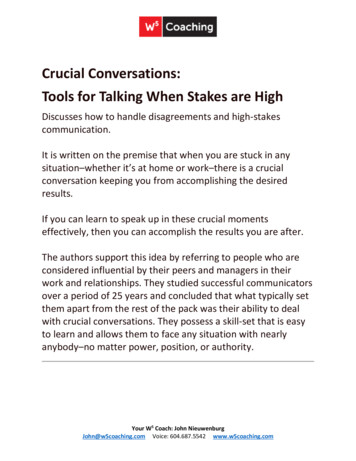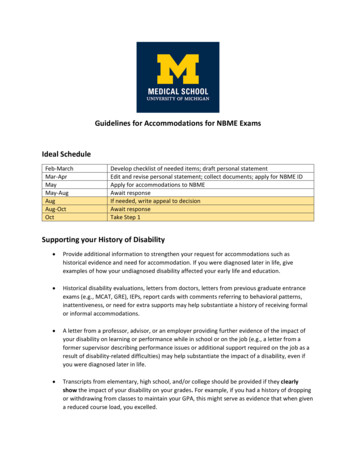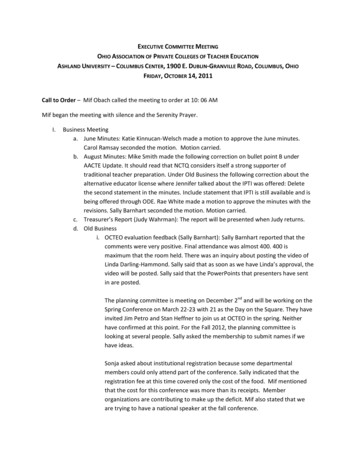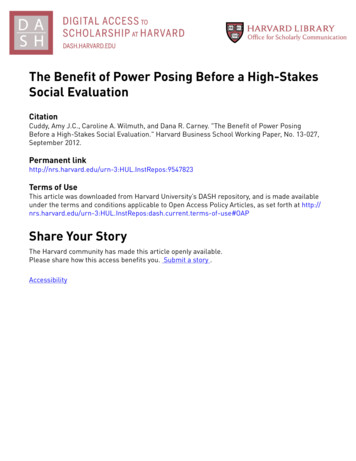
Transcription
ResearchReportAccommodations on Highstakes Writing Tests forStudents With DisabilitiesCara Cahalan-LaitusisResearch &DevelopmentMarch 2004RR-04-13
Accommodations on High-stakes Writing Tests for Students With DisabilitiesCara Cahalan-LaitusisETS, Princeton, NJMarch 2004
As part of its educational and social mission and in fulfilling the organization's nonprofit charterand bylaws, ETS has and continues to learn from and also to lead research that furtherseducational and measurement research to advance quality and equity in education and assessmentfor all users of the organization's products and services.ETS Research Reports provide preliminary and limited dissemination of ETS research prior topublication. To obtain a PDF or a print copy of a report, please right 2004 by Educational Testing Service. All rights reserved.ETS and the ETS logo are registered trademarks ofEducational Testing Service (ETS).
AbstractWith the addition of a writing component to many high-stakes tests (e.g., college admission testsand high school exit exams), a review of writing accommodations for students with disabilitiesbecomes critical. This paper reviews the accommodation policies of 20 states with high schoolexit exams of writing and three testing organizations that administer high-stakes tests that assesswriting. In addition, this paper reviews existing research on testing accommodations, specificallythose that focus on writing assessments. A section on assistive technologies for writing is alsoincluded, because these technologies are becoming more widely used and are likely to berequested as testing accommodations. Finally, recommendations for needed research areprovided.Key words: Writing accommodations, assistive technologies, disabilitiesi
AcknowledgmentsThe author wishes to thank June Zumoff, Linda Cook, and Cathy Wendler for providing valuablereviews of this paper and the College Board for providing funding for this work.ii
Table of ContentsPageIntroduction. 1Accommodations . 2Current Policy on Accommodations for Students With Disabilities . 3Presentation . 7Response. 10Setting. 13Timing and Scheduling. 13Research on Accommodations for Students With Disabilities . 17Presentation . 17Response. 18Setting. 22Timing . 23Summary of Research. 23Current and Future Assistive Technologies for Writing. 24Conclusions. 26References. 27Appendix. 31iii
List of TablesPageTable 1.High-stakes State Writing Tests, by Item Type . 4Table 2.High-stakes Admission, Licensure, and Placement Writing Tests, by Item Type . 6Table 3.Presentation Accommodations and Modifications . 8Table 4.Response Accommodations and Modifications. 11Table 5.Setting Accommodations and Modifications. 14Table 6.Timing and Scheduling Accommodations and Modifications. 16iv
IntroductionIn 1990, the Americans with Disabilities Act (ADA) was enacted to prohibitdiscrimination against individuals with disabilities and mandated equal access to public servicesand facilities. The ADA also placed responsibility on the test administrator for ensuring that testscores accurately reflect the construct being measured and not the test taker’s disability, unlessthe skills affected by the disability are those being assessed. The legislation referred to anaccommodation as any variation in the specified assessment environment or process that doesnot alter in any significant way what the test measures or the comparability of scores.Accommodations include variations in test scheduling, setting, response, and presentation formatwithout which the assessment may not accurately measure the test taker’s knowledge or skills.Currently, all testing organizations that administer admission tests provideaccommodations. Most states were slow to include students with disabilities in state assessments.Before the reauthorization of the Individuals with Disabilities Education Act (IDEA) in 1997,states’ policies on testing students with disabilities were less clearly defined than they are today,and many students with disabilities were excluded from state assessments. The Individuals withDisabilities Act (IDEA, 1997) states that all students should participate in assessments (Section300.138a). The law also mandates that decisions regarding testing accommodations be supportedby the student’s Individualized Education Plan (IEP) (Section 300.342b). Decisions regardinghow a student will be assessed (e.g., alternate assessment, general assessment withaccommodations) are typically made by the IEP team using guidelines provided by the statedepartment of education and information about the student and the test.With the addition of a writing component to many high-stakes tests (e.g., collegeadmission tests and high school exit exams), a review of writing accommodations for studentswith disabilities becomes critical. This paper reviews the accommodation policies of 20 stateswith high school exit exams of writing, and three testing organizations that administer highstakes tests that assess writing. In addition, this paper reviews existing research on testingaccommodations, specifically those that focus on writing assessments. A section on assistivetechnologies for writing is also included, because these technologies are becoming more widelyused and are likely to be requested as testing accommodations. Finally, recommendations fornecessary research are provided.1
AccommodationsThe guidelines regarding testing students with disabilities vary by state and testingprogram, but most policies differentiate between testing accommodations and testingmodifications. Accommodations are sometimes referred to as “allowable accommodations” or“standard accommodations” and do not alter the construct of the test. Modifications do alter thetest’s construct and are sometimes referred to as “nonallowable accommodations” or“nonstandard accommodations.” Each state or testing program determines what accommodationsand modifications are permitted and how test scores will be reported and used whenmodifications are allowed.Testing accommodations (and modifications) are commonly grouped into four categories:presentation, response, timing, and setting. Presentation accommodations provide test takers withan alternative presentation of testing materials, such as Braille, large print, and audiocassettes.Response accommodations give test takers alternative options for responding to the assessment,and include the use of a scribe or computer to record responses on multiple-choice and essaytests. Timing accommodations include extended time, the most widely requestedaccommodation, as well as frequent breaks and multiple testing sessions. Settingaccommodations consist of a private room, screens to block out distractions, and other changesto the test taker’s surroundings. Any one of these accommodations may be considered a testmodification, depending on the construct the test is measuring (e.g., spelling, composition,grammar, creativity). Most states differentiate between accommodations and modifications, andprovide a list of each in their guidelines for testing students with disabilities.Phillips (1994) argues that measurement specialists should consider the impact ofmodifications on the constructs measured and the test’s validity. Once modifications havechanged test constructs for some individuals, the users of the test can no longer rely on its abilityto determine qualifications for graduation, admission, employment, certification, or licensure.Phillips also argues that, even if an examinee with a disability is incapable of adapting to thestandard testing administration, any change to testing conditions should be avoided if the changewould (a) alter the skill being measured, (b) preclude the comparability of scores betweenexaminees that received accommodations and those that did not, or (c) allow examinees withoutdisabilities to benefit (if they were granted the same accommodation). This last criterion isdebatable; in fact, several researchers have recently argued that accommodations should only be2
provided if they offer a “differential” boost to students with disabilities (Elliott & McKevitt,2000; Fuchs & Fuchs, 1999, Pitoniak & Royer, 2001). Differential boost indicates that bothstudents with disabilities and those without disabilities benefit from an accommodation, but thatstudents with disabilities benefit more from the accommodation than students withoutdisabilities.Current Policy on Accommodations for Students With DisabilitiesMost states and testing organizations use Phillips’ first criterion (i.e., alter the skill beingmeasured) to determine whether a test accommodation is an allowable accommodation or anonallowable modification. However, because the testing constructs vary, there is someinconsistency between what each state and testing organization considers an accommodation andwhat they consider to be a modification.States with high school exit exams that did not testwriting (e.g., Florida and North Carolina) were excluded from this review, but 7 states(California, Indiana, Louisiana, Maryland, Massachusetts, Mississippi, and New York) thatassessed writing as part of another construct (e.g., writing an essay as part of the language arts orscience exam) were included. The remaining 13 states that included writing in their exit examsused a stand-alone writing examination to assess students. Of the 20 states reviewed, 9 states hadgraduation tests that were not required for the class of 2003, but will be required for studentsgraduating in the future. The writing test questions varied from only multiple-choice questions(Alabama) to a combination of multiple-choice, short constructed-response, and longer essayquestions (Alaska, Arizona, and Washington). Table 1 provides the type of test questions by stateand specific test, while Table 2 provides the type of test questions included in admission,placement, and professional examinations. The remainder of this section reviews the state andtesting organization policies on the most commonly requested accommodations from eachcategory (i.e., presentation, response, timing/scheduling, and setting) for tests that assess writing.3
Table 1High-stakes State Writing Tests, by Item TypeShortconstructedresponseEssayXXXHigh School Graduation Qualifying ExaminationXXXArizona Instrument to Measure Standards (AIMS)MultipleState/testing program choiceAlabamaXAlaskaArizonaaaCalifornia1XName of testAlabama High School Graduation Exam (AHSGE)XCalifornia High School Exit Exam (CAHSEE)DelawareXDelaware Student Testing Program (DSTP) achusettsMinnesotaMississippiXa1Georgia High School Writing Test (GHSWT)XIndiana Graduation Qualifying ExamX1Graduation Exit Examination for the 21st Century (GEE21)1Maryland High School Assessment1XMassachusetts Comprehensive Assessment System (MCAS)XBasic Skills TestsX1Subject Area Testing Program (SATP)1XNew JerseyXHigh School Proficiency Assessment (HSPA)New MexicoXNew Mexico High School Competency Examination (NMHSCE)1New YorkTennesseeaXRegents Competency TestsXTennessee Comprehensive Assessment Program (TCAP)(Table continues)
Table 1 (continued)MultipleState/testing program choiceTexas aUtah aVirginiaShortconstructedresponseWashingtonName of testTexas Assessment of Academic Skills (TAAS) or End-of-CourseExaminationsXXXXUtah Basic Skills Competency Test (UBSCT)XStandards of Learning (SOL) End-of-Course AssessmentsXWashington Assessment of Student Learning (WASL)aaEssayXXNote. These tests require an essay component on another test (e.g., English II or Language Arts) but do not have a stand-alone writingassessment.aIndicates that the exit exam was not a graduation requirement for students who graduated in 2003, but will be a requirement in thefuture.5
Table 2High-stakes Admission, Licensure, and Placement Writing Tests, by Item TypeShortMultiple- constructedresponseEssaychoiceName of testACT AssessmentXACT Assessment: Writing (administration to begin in fall 2004)CAAPXXCollegiate Assessment of Academic Performance Writing Skills and EssayCOMPASS/ESLXXCOMPASS/ESL: Writing SkillsXWorkKeys:Business WritingXaAdvanced Placement Test (variety of subject-matter tests)Testing programACT Tests:WorkKeysCollege Board Tests:AP PSAT/NMSQT XPSAT/NMSQT: Writing Skills6 XXSAT I Reasoning Test: Writing (administration to begin in fall 2004)SAT IIXXSAT II: WritingXGMAT: Analytical Writing Assessment SectionXGRE: Analytical Writing SectionXXPre-Professional Skills Test: Writing; some PRAXIS II subject testsXXTOEFL: Structure/WritingSAT IETS Tests:GMAT GREPRAXIS TOEFLaThis test requires an essay component on another test (e.g., English II or Language Arts) but does not have a stand-alone writingassessment.
PresentationAltering the presentation format of a writing test results in a wide variety of presentationsthat vary in terms of changes to the construct of the test. Table 3 displays presentationaccommodations and modifications by state and testing organization. None of the states ortesting organizations reviewed in this paper considered visual aids, large-print test format, orBraille test format as a testing modification. One state listed orientation aides (e.g., providingmasks or markers to block out unnecessary information and to help the test takers maintain theirplace, or highlighting key words in the directions) as modifications; the other states either madeno mention of orientation aids or considered them to be accommodations. Eleven statesidentified allowing a test administrator to paraphrase test content as a modification, one statetermed it an accommodation, and eight states did not mention paraphrasing. Paraphrasing of testdirections was more likely to be an accommodation (eight states) than a modification (fourstates). For all ETS and College Board tests, paraphrasing of test content is not allowed, butreducing the number of test items per page and orientation aids are allowable accommodations.Currently, ETS does not have an official policy on paraphrasing test directions, but it is notallowed on College Board tests. ACT makes no mention of paraphrasing test content ordirections.Audio (or signing) presentation includes reading the entire test aloud, signing the test(items and directions), providing an audiocassette of the test material, and allowing the use ofscreen reader software. Most states determined which audio/signing accommodations wereappropriate based on the content of the test. Of the 20 states reviewed, 18 considered audio orsigning presentations (e.g., a reader, audio tape, or translation via American Sign Language)accommodations for test questions that assessed writing, 3 states consider these to bemodifications, and 1 state did not specify. Only 2 states identified the audio/signing presentationof directions as a modification. The College Board, ACT, and ETS consider audio presentationof written material an allowable accommodation, but ETS and the College Board do not allowfor the signing of test content because it may change the meaning of test questions. ETS isconsidering revising its policy on signing test content, for the writing prompts only, on essaytests. Signing of test directions is an allowable accommodation on College Board tests as well asother ETS-administered tests.7
Table 3Presentation Accommodations and ModificationsAudio/signingpresentation of orniaaVisual rgeprintABrailleAReduce #Orientation of items Paraphrasing Paraphrasingper page ettsAAAAMinnesotaAAAMississippiMMANew JerseyAANew MexicoAANew AAAAAMMAAAAAAMAAAAAMMAAAAMAAAA(Table continues)
Table 3 (continued)Audio/signingpresentation of textVisual MAACT testsAAAAACollege BoardtestsAbAAAAAMAOther ETSadministered tests herReduce #Orientation of items Paraphrasing Paraphrasingper page itemsdirectionsaidsALLAM9Note. A accommodation; M modification; P modification for some, but not all, test items; ALL allowed for all test takers,regardless of disability.aIndicates that the exit exam was not a graduation requirement for students who graduated in 2003, but will be a requirement in thefuture. bDoes not allow signing of test content, but does allow a reader for test content. cPolicy on signing writing test items iscurrently under development.
ResponseTable 4 displays response accommodations and modifications by state and testingorganization. All of the state guidelines on accommodations mentioned at least one oral response,such as dictating to a scribe, dictating into a tape recorder, or using voice recognition software. Themost common oral response was dictating to a scribe. On multiple-choice test items, all 20 statesdetermined that dictating to a scribe was an accommodation. The pattern was similar for writingcomposition test items (18 determined dictating to a scribe to be an accommodation and 2considered it a modification). States did vary, however, in what an examinee was required todictate on composition test questions. For example, some states required test takers to speak whatthey wanted written, while other states required examinees to spell every word and indicate allpunctuation marks. Examples of state guidelines for a scribe can be found in the appendix. All ofthe admission tests reviewed consider a scribe an accommodation for essay, constructed-response,and multiple-choice items, despite the absence of any guidelines requiring examinees todemonstrate knowledge of spelling, grammar, and punctuation.All states identified a word processor or typewriter as an accommodation, but most statesidentified supporting software (i.e., word prediction, spell checker, and grammar checker) as amodification for tests of writing. Two states that do not allow spell-check software do allowexaminees to use a dictionary or spell-check book. Several assistive technologies, includingBraillers, communication boards, and closed-captioned television, were consideredaccommodations because they were not considered likely to change the construct of the test.Currently, the College Board does allow the use of a computer as an accommodation on the SATII: Subject Tests (including the SAT II: Writing Test), but supervisors are told to prohibitstudents from using spell check, grammar check, thesaurus, or any other assistive softwareprograms. On ETS-administered computer-based tests that have an essay component (i.e., GRE ,GMAT , and TOEFL ), all test takers are provided with a simplified word processing program.On the paper-based PRAXIS essay tests, examinees with disabilities are allowed to use astandard word processor. A spell check program is an available accommodation for PRAXIS,GRE, GMAT, and TOEFL, but it is infrequently allowed because of the strict guidelines forapproval. When spell check is approved as an accommodation, a basic spell check program issent to the test administrator for use; all other assistive programs (e.g., grammar check,10
Table 4Response Accommodations and ModificationsOral n ve devices/technologiesWordGrammar WordThat do processor . Spellpredictionnot alter or type- check checkbconstruct writersoftware software naAMAMAAAAAAAAAAAMMAAAAAPAAMMississippiAAANew JerseyAAANew MexicoAAAMNew landMarkanswers Spell checkin test or regularbooklet dictionaryAAAaPoint AAAAA(Table continues)
Table 4 (continued)Oral responseVoicerecognition Tapesoftwarerecorder ScribeAState/testingprogramTexasaUtahaAssistive devices/technologiesWordGrammar WordThat do processor Spellpredictionnot alter orcheck checkbconstruct typewriter software software softwareAAMMarkanswersPoint to in testanswers bookletAAAAAAPAAAAWashingtonAAAAMMACT TestsAAAAVirginiaaaCollege BoardtestsMAAMMOtherSpell checkor regulardictionaryAAAMMAAAAM12Other ETSadministered testsAAAAAMMAAMNote. A accommodation; M modification; P modification for some, but not all, test items; ALL allowed for all test takers regardlessof disability.aIndicates that the exit exam was not a graduation requirement for students who graduated in 2003, but will be a requirement in thefuture. bAssistive technologies that do not alter construct includes communication boards or devices, speech synthesizers, speechrecognition software, close-captioned or video materials, test-talk converters, auditory trainer, Braille writers.
thesaurus, word prediction) are not allowed. ACT does not provide any guidelines fordetermining which assistive technologies will be allowed.Other response accommodations and modifications that were identified in the stateguidelines include pointing to answers (7 states defined as an accommodation) and markinganswers in test books (17 states defined as an accommodation; 3states did not specify). For alltests administered by the College Board, ACT, and ETS, pointing to answers and markinganswers in the test booklet are allowable accommodations.SettingAll 20 states identified at least one change to setting as an accommodation, but none ofthese changes were viewed as modifications. A summary of setting accommodations specifiedby each state can be found in Table 5. Accommodations included special adaptive tools orfurniture, special acoustics or lighting, individual testing, small-group testing, individualenclosure (e.g., study carrel), alternative test site (e.g., home or hospital), preferential seating(e.g., facing the examiner or the front of the room), and using a familiar test administrator. TheCollege Board, ACT, and ETS consider most of these changes to setting to be testingaccommodations; on ETS and College Board tests, however, examinees are not allowed to havea familiar test administrator (e.g., family, friend, personal tutor), and ACT does not specify.Timing and SchedulingA summary of the accommodations and modifications of test timing or scheduling can be foundin Table 6. Many high school exit exams have liberal timing allotments for all students, and noneof the states in this study identified extra time, frequent breaks, different test day or time, orchanging the order of test sections as a test modification. One state (Minnesota) identifiedmultiple testing days as a modification. Until recently, ETS, ACT, and the College Board“flagged” test scores if a test taker received extra time. Flagged test scores were identified withan asterisk and a notation indicating that the test was taken under nonstandard conditions, but didnot specifically identify the test taker as disabled. This policy was discontinued in October 2003for all College Board and ACT tests; it was discontinued in October 2001 for all other ETSadministered tests.13
Table 5Setting Accommodations and ModificationsSpecialAdaptivefurniture or lighting oracousticsState/testing program toolsAlabamaAAAlaskaIndividualcarrel orstudyenclosureASeparateroom with Individual orsmall-group Alternativedirecttest sitesupervision ntial Familiar AMassachusetts AAAAAMinnesotaALLALLALLALLALLMississippiAAAAANew JerseyAAAAANew MexicoAAANew YorkAAAAAAAA(Table continues)
Table 5 (continued)State/testing programAdaptive Specialfurniture lighting oror tools acousticsTennesseeaTexasIndividualcarrel orstudyenclosureAaSeparateroom withdirectsupervisionAIndividual orsmall-group Alternativesettingtest siteAAPreferential Familiar tonALLALLALLALLALLAALLACT testsAAACollege BoardtestsAAAAAAAMOther ETSadministered tests AAAAAAAMVirginiaaaAAA15Note. A accommodation; M modification; P modification for some, but not all, test items; ALL allowed for all test takers regardlessof disability.aIndicates that the exit exam was not a graduation requirement for students who graduated in 2003, but will be a requirement in thefuture.
Table 6Timing and Scheduling Accommodations and ModificationsTimingState/testing hedulingMultipletest daysBreaksAAAAALLAAALLAAOptimal timeof sachusettsALLAAAMinnesotaALLMALLMississippiANew JerseyALouisianaMarylandaaNew MexicoNew nALLALLALLALLACT testsAAACollege Board tests AAAAOther ETSadministered testsAAATexasaUtahaVirginiaaaANote. A accommodation; M modification; P modification for some, but not all, test items;ALL allowed for all test takers regardless of disability.aIndicates that the exit exam was not a graduation requirement for students who graduatedin 2003, but will be a requirement in the future.16
Research on Accommodations for Students With DisabilitiesAlthough the intention behind each accommodation is to provide equal access byremoving unnecessary challenges that create construct-irrelevant variance, some types ofaccommodations appear to change the construct of tests and alter the validity of test scores.Research should be conducted to determine whether these sorts of accommodations do alter testconstructs and, if they do, under what conditions. However, research in this area is difficult toconduct due to the (a) multiple types of accommodations, (b) variety of disabilities and thediffering levels of severity, (c) controversy regarding how each accommodation may or may notchange a test’s construct, and (d) inability to aggregate data across administrations because ofdatabase shortcomings. Although a variety of research has been conducted on testingaccommodations (Tindal & Fuchs, 2000), very little research has been specific toaccommodations on writing tests. For this reason, all of the published research on writingaccommodations has been included in this paper. It should be noted, however, that some of thesestudies have very small sample sizes and strict experimental designs were not universallyfollowed, so generalizations to other testing programs may not be possible.PresentationBraille and large print. No research studies were found that examined the impact oflarge-print or Braille accommodations on writing tests. However, three studies were found thatexamined the impact of large-print or Braille on nonwriting tests for high school and adult testtakers (Bennett, Rock, & Jirele, 1987; Bennett, Rock, & Kaplan, 1987; Burk, 1998). In all threestudies, examinees with visual disabilities performed worse than those without disabilities, evenwhen appropriate accommodations were provided. Results indicated that an accommodation oflarge print (or Braille) with extended time improved the performance of students with low vision.Since the large-print and Braille accommodations were always administered with extended time,researchers were unable to separate out the impact of extended time from the changes to printingformat.Audio presentation. No studies have been published that examined the effect of audiopresentation on writing tests. Before 1998, however, four studies were conducted on audiopresentation (i.e., human reader, audiocassette, or text-to-speech conversion software) fornonwriting tests and are described in a review by Tindal and Fuchs (2000). These studiesindicated that students with learning disabilities benefit from the audio presentation17
accommodations, but Tindal and Fuchs advi
GMAT X GMAT: Analytical Writing Assessment Section GRE X GRE: Analytical Writing Section PRAXIS X X Pre-Professional Skills Test: Writing; some PRAXIS II subject tests TOEFL X XTOEFL: Structure/Writing 6 aThis test requires an essay component on another test (e.g., English II or Language Arts) but does not have a stand-alone writing










